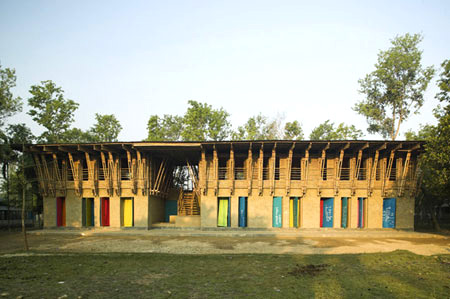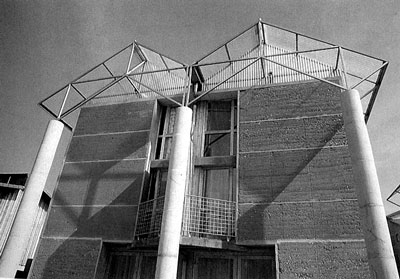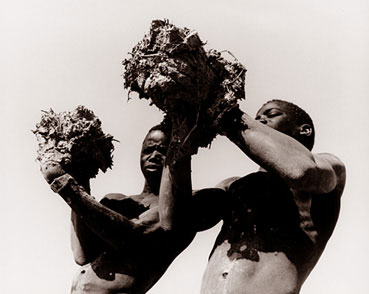Rammed Earth South Korea is a new blog with some curious rammed earth sculptures.
Handmade School

Architects Anna Heringer and Eike Roswag from Linz and Berlin have realized a beautiful school that is a recipient of The Architectural Review Awards for Emerging Architecture.
Refining the local technique of using very wet loam to build walls, the school has a brick foundation, a damp proof course, and walls made of a mixture of loam and straw, the latter acting as a form of reinforcement. The loam and straw are combined by getting cows and water buffalo to tread them in. The ‘Wellerbau’ technique employed here involves building a 700mm high wall layer, leaving it to dry for two days, and trimming off with a spade. A further drying period is followed by the addition of the next layer.
Qurna Residents are Displaced Again
Bulldozers have moved in to demolish houses in the Egyptian village of Qurna (Gourna) which sits on top of dozens of pharaonic tombs in Luxor. The Egyptian government is determined to move the 3,200 families of the village to an alternative settlement it has built a few kilometres away. In 1945 the Egyptian government displaced the entire city to a New Gourna designed by the architect Hassan Fathy. “All of the architect’s best intentions, however, were no match for the avariciousness of the Gournis themselves, who took every opportunity possible to sabotage their new village in order to stay where they were and to continue their own crude but lucrative version of amateur archaeology.” Today New Gourna is almost abandoned and all what remains today of New Gourna is the mosque, market and a couple of houses. Perhaps history will repeat itself and the residents of Qurna will resist forced displacement. However if destruction of the village continues, an important history will be lost. [ images of New Gourna | Qurna ]
Maisons en Terre | Rammed Earth Housing

Completed in 1981, Maisons en Terre by architects Francoise Jourda and Gilles Perraudin was one of many projects for earth housing built in the earth village of the Isle of Abeau.
Adobe USA 2007
The 4th Adobe Conference of the Adobe Association of the Southwest: AdobeUSA 2007 will take place May 18, 19, 20 and 22, 2007 in El Rito, New Mexico on the campus of co-sponsor Northern New Mexico Community College in Cutting Hall Auditorium. It adjoins the two-story South Dorm and Cafeteria forming a stately adobe complex.
Information on the Association and the previous conferences can be found at: http://www.adobeasw.com/
Call for Papers Schedule:
December 15, 2006: Abstracts due. One page, 8-1/2 x11, maximum
January 5, 2007: Notification of acceptance
February 23, 2007: Full paper due. (7-page maximum including graphics)
Presenters will have 20 minutes for presentation and 10 minutes to answer questions. Time limits will be carefully monitored. The host institution can handle 2×2 slides in Carousels, digital presentation files, DVD, VHS and overheads.
Submit abstracts to:
Quentin Wilson, Speakers Committee
PO Box 426, El Rito, NM 87530
505-581-4130 fax
or qwilson@mail.nnmc.edu as an attachment in .txt, .doc (msword) or .pdf format or email body or printed on paper.
Final papers for publication consideration must be in .pdf or .doc formats. Conference Languages: English and Spanish
Topics of special interest are:
Affordable adobe construction
Thermal properties of earthen materials
Physical properties of earthen materials including seismic considerations
Historical buildings of note
Historical builders, developers, architects or designers worldwide
New projects: architecture, adobe art and design
Adobe education
Manufacture and supply of adobe and related construction materials
Wirraminna Environmental Education Centre
More than 10 years of hard work paid off yesterday as Wirraminna Environmental Education Centre’s new rammed-earth interpretive building officially opened at Burrumbuttock.
Timbuktu to W2

Stuart Redler exhibits black and white photographs of the people and earthen architecture of Mali, West Africa from November 16th to December 16th simultaneously in London and Timbuktu. photo by Stuart Redler
The Amiriya Madrasa in Rada, Yemen
Caterina Borelli (independent filmmaker and senior producer RAI-TV 1), produced this documentary based on AIYS Board Member Selma Al-Radi’s restoration work at the Amiriya Madrasa, Rada’ as an ECA/AIYS fellowship project.
Heavenly Mud
Heavenly Mud is a documentary about traditional architecture and magic in West Africa. The documentary celebrates traditional West African architecture, which uses mud (adobe) as its main material. The film will place it in the context of modern Western architecture and link it to the present movement towards our architectural roots embodied by organic architecture. The film was shot by Ton van der Lee and was broadcast by AVRO Television. It can be purchased here.
Building With Cob: A Step-by-step Guide

Cob building uses a simple mixture of clay subsoil, aggregate, straw, and water to create solid structural walls, built without shuttering or forms, on a stone plinth. This ancient practice has been used throughout Britain for centuries – in fact, the material is so strong and durable that it is currently in use for forty-five thousand houses in Cornwall, a county in southern England. Building With Cob: A Step-by-step Guide, by Adam Weismann and Katy Bryce, covers everything from design, planning, and siting to roofs, insulation, and floors. It is lavishly illustrated with more than three hundred inspirational color photographs. The authors have recently been commissioned to build a thirty-classroom school in England in 2006; it will be the largest new cob construction project in the Western hemisphere.
